Dentistry is a rapidly developing branch of medicine, widely using innovative technologies. Not so long ago, the choice of treatment for a caries-affected or injured tooth was quite limited - filling or extraction, traditional restoration with a crown. New technologies have significantly expanded the scope of services offered, and the doctor can offer the most best option.
The most concerning questions for patients are how to restore the chewing ability of teeth, is it possible to save a damaged tooth, and what is better - or a crown? There is no definite answer; in each case, the doctor makes a decision after an initial examination. However, obtain information about possible ways dental care not superfluous at all.
A persistent dislike for visiting the dental office often leads to sad consequences - carious formations gradually expand and deepen, mercilessly affecting the walls of the teeth. Filling does not always give a long-term favorable prognosis in such cases - if the cavity is too large, even a well-placed filling may fall out or, even worse, the thinned tooth wall may collapse. In such cases, the doctor uses an inlay for restoration - a miniature prosthesis that perfectly fills the cavity and follows the natural relief of the tooth. His unique properties explained by a meticulous manufacturing algorithm:
- after removing carious formations and preparing the tooth cavity, the doctor takes an impression of the dentition to send to a special laboratory;
- After modeling a three-dimensional structure using digital processing, the data is used to manufacture the structure automatically;
- the final stage is heat treatment and giving the product an aesthetic appearance. To fix the finished tab, you will only have to sit in the dentist’s chair for a few minutes.
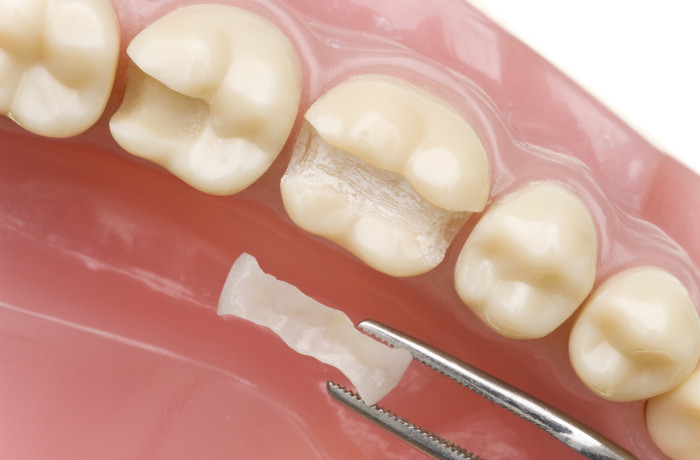
In terms of strength, durability and aesthetics, restorative inlays have undoubted advantages over traditional fillings. Unlike crowns, which restore aesthetic appeal after filling, inlays cover only part of the surface and are visually a continuation of the natural tooth. For their production in a dental laboratory, pressed ceramics and metal alloys are used. The products do not shrink and fit tightly to hard tissues, which allows you to avoid the appearance of secondary caries and, by analogy with a filling, falling out of the tooth cavity. The inlay is designed to recreate the natural shape and color of the tooth; it completely restores the lost function of chewing. The color of the product does not change over time and perfectly matches the natural one.
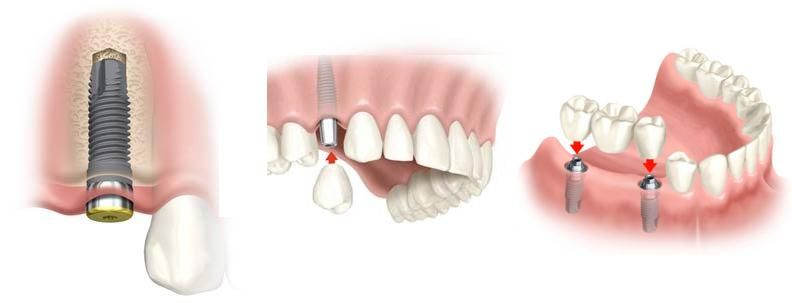
If tooth decay has reached a stage where it is no longer possible to install an inlay, the doctor suggests a metal, ceramic, composite, or other modern material. This is necessary if:
- the tooth is more than half destroyed;
- removal of the nerve led to increased fragility of the “dead” tooth;
- Repeated fillings have thinned the walls of the tooth and there is a risk of their breakage.
Thus, it is impossible to unequivocally answer the question of what is better: a restorative inlay or a crown. The answer depends on the degree of tooth decay and the specialist’s recommendations after examination. Lateral teeth, on which inlays are usually placed, are subjected to significant stress every day. If there are problems with them, you should not put off visiting the dentist - depulping a tooth with advanced caries will leave no choice, you will have to install a crown. Despite all the attractiveness of microprosthetics, you should not insist if the doctor recommends a more suitable option for you.
A permanent crown is a microprosthetic tooth that restores its anatomical shape. Sometimes this treatment method is the only way to save a damaged tooth.
IN orthopedic dentistry prosthetics with a microprosthesis are indicated in the following cases:
- Carious destruction of more than 50% of the tooth surface.
- Traumatic fracture.
- Repeated loss of composite filling.
Preparing the root for installing a tab
During the examination of the patient, the dentist draws special attention for such moments:
- The ratio of the height of the preserved hard tissues of the tooth to the nearby gingival margin. To achieve positive result For future restoration, the tooth root should be 1-2 mm above the gum level.
- For chewing teeth, the interroot area must maintain its integrity.
After visual and instrumental examination oral cavity The specialist sends the patient for an x-ray. On sight X-ray image the doctor assesses the condition of the periodontium ( ligamentous apparatus tooth), structure bone tissue and the presence of filling material in the root canals. It should be taken into account that the tooth to be reconstructed must be perfectly filled. The quality of endodontic treatment directly affects the durability of the inlay.
If during the examination the dentist identifies an unfilled canal, the patient will have the problem tooth refilled.
Contraindications to orthopedic treatment using inlays
In dentistry, the installation of root stump inlays is considered unacceptable under the following conditions:
- The presence of a granuloma or cyst at the root apex.
- Poorly filled root canals.
- Perforation (through hole) in the area of physiological separation of the roots of a chewing tooth.
- Concomitant gingivitis, periodontitis or periodontitis.
- Resorption (melting) of nearby bone plate more than a third of its height or mobility of the damaged tooth.
- Traumatic fracture or dislocation of a tooth root.
Depending on the purpose of prosthetics, inlays are usually divided into two large groups:
- Restorative dental tab, which is intended for reconstruction anatomical shape dental surface. As a rule, they completely match the color of the tooth being restored.
- Root stump tab. This is the so-called crown tab. This microprosthesis is designed to form a support for a non-removable orthopedic structure. Stump structures are usually made of metal alloys.

Depending on the material, experts distinguish the following types designs:
- Composite restorations. They are, in fact, not much different from traditional fillings. The only difference between this method of prosthetics is considered to be high precision, since it is manufactured in laboratory conditions.
- Ceramic inlays. These are highly aesthetic restorations that are distinguished by the reliability and durability of their design.
- Metal stump inlays. This group inlays refers to stump reconstructions. They can be made from cobalt-chrome-nickel alloy (CHN-alloy), silver or precious metals.
KHN-tabs do not call allergic reactions and are not subject to corrosion.
Silver as the main material has bactericidal properties. But in lately Such designs are practically not used in orthopedic dentistry due to high probability pigmentation of the nearby gums, which negatively affects the aesthetic appearance of the restoration.
Inlays made of precious metals are considered completely inert for the patient (do not cause side effects) and accurate.
Design features of tabs
The tooth inlay for the crown consists of two parts:
- A post is a metal rod that is placed in the root and fixed with dental cement.
- Stump. Surface part corresponding physiological form tooth
According to theory, the length of the pin part should be three times the height of the stump part.
In orthopedic practice, doctors sometimes recommend installing a collapsible version of stump inlays. In such cases, the tab consists of two parts, which are alternately installed in the tooth root. The indication for such prosthetics is a significant divergence of the longitudinal axes of the roots.
Inlay manufacturing technology
Prosthetics for patients with root stump inlays is carried out in two main ways:
- Direct technique. At the first visit, the dentist prepares the damaged tooth and calibrates the root canal with special cutters for further impression taking. After this, the doctor takes an impression of the root stump tab, using a polymer pin and C-Silicone. The resulting cast is sent to the laboratory, where a plaster model is cast and the structure is modeled in wax, then the wax is replaced with metal. The prepared tooth is covered with a temporary filling. At the second visit, the orthopedic doctor fixes the orthopedic structure at the root of the tooth.
- Indirect method. At the initial visit, the specialist performs mechanical treatment of the bone tissue defect. The doctor excises all pigmented and non-viable dental tissue. The dentist also widens the orifices and the root canals themselves. After preparation, an impression of the patient's upper and lower jaw and record the nature of the closure of the dentition. In a dental laboratory, a technician models and casts a metal inlay that takes into account individual characteristics the structure of the patient's oral cavity. At the follow-up appointment, the orthopedist fixes the restoration using glass ionomer cement.
Advantages of orthopedic treatment with inlays
Today, dental inlays under a crown are considered the most in an efficient way restoration of a significantly damaged tooth. The stump inlay, in contrast to anchor and parapulp pins, has the most physiological
distributes chewing pressure. This eliminates the possibility of the tooth root splitting during chewing. In addition, the stump inlay provides a reliable support for artificial crowns and bridges.
Cosmetic microprostheses made of composite and ceramic materials provide high aesthetics of restoration. Teeth restored in this way can last for many years.
Features of tooth preparation for inlay prosthetics
The reliability of prosthetics depends on the following factors:
- Complete sealing of the root canals.
- The root part should occupy at least two thirds of the length of the root.
- When preparing hard tissue, the dentist must avoid excessive thinning of the canal walls or the area of bifurcated roots.
- No perforations and inflammatory processes in periodontal tissues.
Establishment procedure
The production and fixation of a microprosthesis is carried out in two visits to the dentist. Anesthesia is usually not required. This is due to the fact that there are no nerve endings in the restored root and all dental procedures are absolutely painless.
Clinical stages of prosthetics include:
- Examination and consultation with an orthopedic doctor.
- Mechanical treatment of a damaged tooth using a drill.
- Taking an impression of the jaws. The cast must be two-component. First, the dentist places a base impression mass, which is in a dough-like form, into the patient’s oral cavity. The second part of the impression is made up of liquid silicone, which penetrates into all the recesses of the tooth. This technology allows you to obtain a detailed and high-quality mirror image of the prosthetic bed.
- Fixation of the finished orthopedic structure. To do this, the restored root is isolated from saliva and oral fluid. In such cases, a rubber dam is installed on the patient. The microprosthesis is fixed using special cement. The best fixation agent is considered to be glass ionomer material, which has high durability and low shrinkage.
Care of the stump orthopedic microprosthesis
- Hygienic care for such a restoration is carried out in the form of twice-daily brushing of teeth with a toothbrush and toothpaste. Thorough cleaning of surfaces prevents the development of secondary caries and decementation of the orthopedic structure. A dental crown on an inlay requires regular care.
- After each meal, the patient should rinse the mouth with warm water.
- Cleaning the interdental spaces is done using dental floss.
- Stump inlays must be replaced with an artificial crown no later than 2-3 months.
- Have a preventive dental examination at least once a year.
![]()
Crowns with a metal inlay come in the following forms:
- Disintegration of the restoration, which occurs when the prosthetic algorithm is not followed or fluid penetrates into the root canals during fixation of the structure.
- Tooth root fracture or perforation root canal. This complication occurs after excessive machining damaged tooth.
- Allergic reactions from the oral mucosa. Clinical picture The disease is manifested by swelling and redness of the gums. Allergies can be eliminated only by replacing the tab.
- Pigmentation of soft tissues in the periodontal area. Darkening of the gingival surface is observed when the periodontal tissue comes into contact with the silver insert.
Which artificial crowns are best installed on core inlays?
In modern dental centers It is recommended to use metal-ceramic or ceramic crowns for crowns on teeth on core inlays. These are the most aesthetic and durable restorations. Ceramic material for prosthetics does not change its color and has high performance strength.
After fixing the microprosthesis, experts recommend making a temporary plastic crown, the function of which is to protect the tooth root from bacterial contamination. In addition, temporary prosthetics prevents the growth of gingival tissue in the area of restoration and, as a consequence, the occurrence of bleeding gums.
The procedure for installing a permanent crown on a stump tab
After fixing the root stump tab and removing excess cement, the doctor carries out the following measures:
- Local infiltration anesthesia. It is first necessary to clarify the patient’s allergic status.
- Formation of a subgingival ledge. This is the so-called root step for installing a crown. This prosthetic technique fully restores the dentogingival area of the oral cavity.
- Placement of a retraction cord for temporary gingival detachment.
- Taking impressions of the upper and lower jaw.
- Temporary fixation plastic crown which is done directly in the mouth or in a dental laboratory.
- Trying on the metal frame of the future restoration and selecting the shade of the future tooth.
- Repeated fitting and bite correction.
- Cementation of an artificial crown.
Stump tab or crown - which is better and why?
The question of which restoration method will best restore a damaged tooth is inlay, crown or traditional, worries many patients. However, a final choice in favor of any method can be made only after a preliminary assessment of the condition of the problem tooth, its antagonists, tissues surrounding the tooth, etc., that is general conditions For . Without this, discussions about the benefits of inlays or crowns are similar to an argument about what tastes better: honey or black caviar. Indications for installation inlays and crowns are different, so it is incorrect to compare them ─ it is better to simply become more familiar with the features and scope of application of these methods.
When will a ceramic inlay help?
A tooth destroyed due to injury or complications of caries can be removed and replaced with an implant-supported denture. But if the tooth tissue is partially preserved, best solution problems tooth restoration─ this ceramic inlay.
The advantages of such an inlay over a filling are indisputable: the inlay is much stronger, more durable, and more resistant to external influences. Avoid pulp removal healthy tooth usually only allows inlay, crown however, it requires deep preparation, after which the tooth becomes “dead”. However, if the tooth requires endodontic treatment, or has already been subjected to endodontic treatment, it may be advisable to undergo prosthetics with an artificial crown, under which a core tab on a pin base.
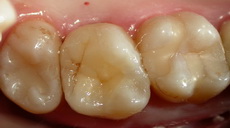
Tooth restoration with a ceramic inlay
In what cases is a crown necessary?
A tooth with very thinned walls is unlikely to be saved by a type of restoration such as a ceramic inlay; a crown in this case is a much more effective method that strengthens the coronal part of the tooth, while the chewing functions of the tooth are preserved in full. A crown will provide a particularly strong and durable restoration if the tooth underneath is not simply filled, but reinforced using a structure such as a core inlay. To restore multi-rooted teeth, the inlay design can be dismountable.

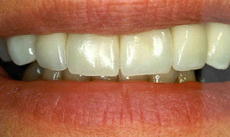
What is a stump tab and what is it for?
Artificially formed stump, or crown inlay, is not independent, but an auxiliary basis for prosthetics. In restoration structures stump pin insert plays the same role as a simple pin, but its reinforcing properties are significantly higher. If the doctor believes that a crown should be installed stump inlay, manufacturing it may take longer than a simple filling on pins and then covering the tooth with a crown. However crown and core inlay form a truly reliable restoration structure, while the risk of destruction under the crown of a tooth with a massive filling is invariably high.
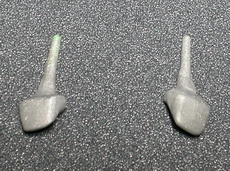

Stump pin inlays Teeth before restoration with stump inlays
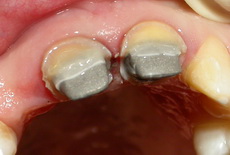
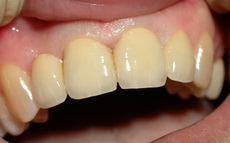
Fixation of core inlays Final restoration of inlay + crown
Depending on possible conditions prosthetics, the pin-stump inlay can be made of various materials. Titanium and zirconium, which have good biocompatibility with teeth, are not always a justified choice for making inlays: in the event of a breakage, the stump inlay made of titanium or zirconium oxide is removed from the canal with considerable difficulty. For restoration chewing teeth The best quality option is considered to be a cast stump inlay made of gold, but many patients are stopped by its high cost.
More acceptable for most patients in need of prosthetics is a cobalt-chromium stump insert, the cost of which is much lower than gold. In addition, cobalt-chromium alloy is successfully used for the manufacture of frameworks for metal-ceramic crowns, which avoids the antagonism of metals in the oral cavity. As for restorations in the frontal area, the use of metal inlays is undesirable from an aesthetic point of view. A ceramic pin inlay (ceramic core inlay) is more appropriate for prosthetics of anterior teeth. If there are increased demands on aesthetics, a metal-ceramic stump inlay is also used, the price of which is slightly lower than that of an inlay made of solid ceramics.
A beautiful smile is important for every person, but teeth are subject to significant stress throughout life and subsequent destruction. Aesthetic inlays instead of metal fillings make a smile natural, because modern dentistry can restore even serious damage tooth crowns. High-quality restoration with restoration of the functional properties of the tooth is guaranteed by dental inlays. can grow in depth or width, destroying one or more teeth at once. It is difficult to reliably fill such a defect, and there are no guarantees that the treatment will not be in vain. In such situations, dental inlays are used in dentistry.
Dental inlays – what are they?
A tooth inlay is an artificial microprosthesis installed in place of destroyed dental tissues with the ability to recreate the anatomical shape of the tooth. An inlay can also be called a filling, which is made in the laboratory in accordance with an exact cast (a regular amalgam filling is modeled in the oral cavity). Microprosthetics with dental inlays is one of the types of fixed prosthetics.
The inlay is superior in its aesthetic characteristics - it looks like an integral part of a molar with the same grooves and grooves, the same color and shape. Making an inlay is a painstaking and time-consuming job, because the inlay must fit perfectly into the prepared cavity.
Indications and contraindications for the use of dental inlays
The main indication for installing inlays is severe caries damage with the loss of up to 60% of dental tissue. Sometimes caries destroys teeth so much that another ordinary filling simply does not hold. For big carious cavity This filling method is optimal. There are other indications for tabs:
- wedge-shaped tooth defect;
- dental injuries;
- mechanical tooth decay;
- dysplasia of dental tissues;
- prosthetics with crowns;
- enamel hypoplasia;
- as a support element when fixing a bridge;
- prevention of tooth abrasion.
Tabs are contraindicated in the following cases:
- small carious cavity;
- approximal cavity of the tooth, extending deep into the dentin;
- increased caries activity;
- insufficient oral hygiene;
- (grinding teeth).
Inlay prosthetic method - advantages and disadvantages
Prosthetics with dental inlays in dentistry has its pros and cons. The advantages include the fact that:
- the inlays do not break or crack, do not undergo polymerization or shrinkage - they are durable and reliable;
- do not lose color over time, resistant to aggressive environments;
- accurately depicts the shape of the tooth;
- When creating an inlay, the characteristics of the bite are taken into account;
- the tab retains its original appearance for the entire period of operation;
- do not create discomfort;
- aesthetically pleasing and as close as possible in appearance to natural teeth;
- protect the nerves of the tooth from infection with caries, pulpitis and other diseases, which significantly extends the life of the tooth even with a large carious cavity;
- tab allows you to save appearance and functions of the tooth;
- it is much more durable than a metal filling;
- prevents abrasion of tooth enamel;
- The insert is fully compatible with various prostheses, increasing the efficiency of prosthetics.
The disadvantages of this type of filling are few:
- installing an inlay takes much longer than a regular filling;
- in view of high cost, self made, complex production of inlays is more expensive than fillings.
Dental inlays: types
- Ceramic dental inlays are the most popular: they are aesthetically pleasing and quite durable.
- Inlays made of composite materials are durable and adhere well to tooth tissues.
- The ideal material for inlays is zirconium dioxide: beautiful appearance, no shrinkage over time, but the price is more expensive than ceramics and composites.
- Dental inlays for crowns are usually made from metal.
Dental inlays can also be divided into:
- restorative - correction and restoration of the shape and color of the tooth crown;
- crown inlay (stump) – to restore the coronal part of a damaged tooth. Then an artificial crown is installed on the stump tab.
Crown inlay: which metal to choose
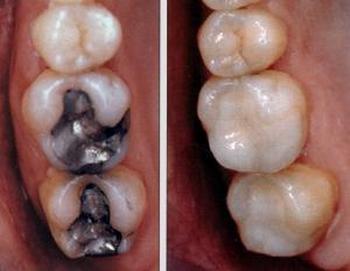 The material for the crown inlay is chosen taking into account many factors, but the main thing is what kind of crowns are used to restore teeth. Inlays are made from the best filling materials, which have high strength and a wide range of colors. Inlays can be made of ceramics, glass-ceramics (glass-based materials), composite synthetic materials and metal alloys. According to aesthetic criteria, glass ceramics, ceramics, porcelain, and composite materials are closer to natural teeth.
The material for the crown inlay is chosen taking into account many factors, but the main thing is what kind of crowns are used to restore teeth. Inlays are made from the best filling materials, which have high strength and a wide range of colors. Inlays can be made of ceramics, glass-ceramics (glass-based materials), composite synthetic materials and metal alloys. According to aesthetic criteria, glass ceramics, ceramics, porcelain, and composite materials are closer to natural teeth.
- Inlay for metal or metal-ceramic crown made from cobalt-chromium alloy. Such inlays are made for prosthetics with metal-ceramic and conventional metal crowns.
- Ceramic crowns are usually made either from a precious alloy (gold-platinum) or lined with ceramic or zirconium dioxide. The best option in terms of its characteristics is a gold inlay for the crown.
- If the crown is on front tooth is made of metal-free ceramics, for example, zirconium dioxide, then the stump inlay should be made of the same material, since the metal of the stump inlay is visible through the ceramic crown, giving it a bluish tint.
- Due to biological inertness, a titanium insert is preferable, but titanium is a rather fragile material.
- Silver-palladium and silver alloys have bactericidal properties. When using silver core inlays, pigmentation of the gums around the tooth may be observed.
- Chromium-cobalt and chromium-nickel alloys have insignificant shrinkage and good strength.
Inlay or veneer – which is better?
There is a lot in common in the manufacture of these structures, so some patients confuse these concepts. In each case, after treatment, an impression is made, and during the second visit, both the inlay and the tooth are installed.
An inlay is, first of all, a restoration of the shape of a tooth, and a veneer is an aesthetic restoration. The same materials can be used for their manufacture - ceramics, composite, etc. Veneers are installed only on the front teeth, so it is necessary that their color be identical to the shade of the enamel. Tabs are most often used on chewing teeth, where aesthetics are not the main thing. That is why inlays are made from any materials, and gold or other metal is not used for veneers.
When is a dental inlay better, and when is a crown
--noindex-->When choosing prosthetics, patients are puzzled by the question: which restoration method is better for restoring a tooth - a crown, an inlay or a traditional filling. An exact answer in favor of a certain method can only be given after analyzing the condition of the problem tooth and its adjacent tissues.
If the cavity is large and the walls of the tooth are thinner, a crown will protect the tooth from further destruction much more reliably. The most durable and reliable restoration will be provided by a crown if the tooth underneath is not just filled, but restored with a stump inlay.
If there is significant damage to the tooth, a titanium insert will help strengthen the inlay.
Methods for making tabs
Inlays for teeth are made different methods: direct, indirect and computer modeling.
- Direct method - the inlay is made after taking an impression of one specific tooth.
- The indirect method involves making an impression of both jaws, taking into account the patient’s bite. The indirect method is more expensive, but also more effective, since the inlay completely matches the tooth configuration without causing discomfort to the patient.
- Modern equipment also allows the use of computer modeling - at the first stage, a photograph of the diseased tooth and both jaws is taken, then a 3-D computer model is recreated using a special robot.
Procedure and price for installing tabs
Prosthetics with inlays is carried out in several stages. At the first visit, the dentist examines the condition of the oral cavity and, if necessary, can take photographs. Prepare the tooth. It can take up to two weeks to make a permanent prosthesis with ready-made impressions. For this period, a temporary filling is installed.
At the next stage, the specialist removes the temporary filling, adjusting the prepared inlay to the size of the tooth. It should fit very tightly to the tooth. When the dentist is convinced that the inlay fits the teeth perfectly, without disturbing the bite, they proceed to fixing the structure.
At local anesthesia it is attached to the tooth with cement or special glue, and after some time the insert is ground. The service life of dental inlays depends on the material from which they are made, on average it is 8 - 10 years. At proper hygiene and careful handling, the service life of the tab can be increased. The price of a dental inlay depends on the type and material for microprosthetics:
- single-root metal – on average 2,000 rubles;
- double-root metal tab - 3,000 rubles;
- three-root metal tab - about 4,000 rubles;
- stump inlay made of zirconium dioxide - from RUB 8,000.
Caring for dental inlays
Hygienic care of inlays involves thorough brushing of teeth, as well as rinsing the mouth with water after eating. The load on the tabs should be limited, especially at first.
If, however, the crown and the inlay fall out, this may indicate a violation of the technique of its fixation. According to the instructions, after installing the tab under the crown, you need to take a break for a day to correct the result. If the drill is used half an hour after installation, the vibration may destroy the uncured cement. In this case, you should immediately consult a doctor to re-fix the crown.
If, after installing the stump tab, toothache, this may indicate increased sensitivity teeth. If your body has not adapted within a few days and the toothache has not stopped, you should see a dentist and take an x-ray.
Dental inlays in modern dentistry– fast, cheap and effective method dental restoration both independently and in combination with other types of microprosthetics, because even a severely damaged tooth with an inlay has hope for a second full life. In the video and photo - dental inlays: types and installation.
--noindex-->Ceramic inlay as modern technology in dentistry occupies an intermediate position between complete restoration tooth and installing a ceramic crown on the tooth. But each type of this work has its own indications and contraindications, as well as pros and cons. What is better for the patient: a ceramic inlay or a crown, and in what cases should they be installed?
What are ceramic inlays?
When a tooth is destroyed by no more than one third, it is most advisable to install a light-composite filling on the tooth. But even modern materials, from which fillings are made, have several disadvantages: during polymerization they shrink, fillings may not completely harden, and over time, chips and deformation may appear inside.
This is why ceramic inlays are becoming increasingly popular and in demand, especially for the restoration of anterior teeth. Oddly enough, a ceramic inlay is also a filling, but it is made not in the oral cavity, but in a dental laboratory. Ceramics, due to their properties, best match the strength and color of the tooth’s own tissues.
What was the reason for using inlays rather than fillings? This impetus was the improvement of the mechanism for attaching light fillings to teeth. For better adhesion of tooth tissues to the filling, tiny irregularities began to be created on the surface of the tooth, where glue could get in and firmly connect the tooth to the filling.
Glue (adhesive material) creates high-strength bonds between the tooth not only with the filling, but also with other materials for inlays (metal, porcelain, ceramics).
Which is better: a ceramic inlay or a crown?
The question of which is better: a ceramic inlay or a crown can be answered this way. It all depends on the degree of tooth destruction and the complexity of the restoration. If the tooth is destroyed by about 1/3 or more, it is better to install a ceramic inlay rather than a filling. But choosing between an inlay and a crown is up to the dentist. A badly damaged tooth can be restored using inlays and crowns.
A ceramic inlay may be preferred to a crown if the tooth has a solid foundation. In cases where the tooth is severely damaged and the base is weak (or missing), you can first place a ceramic stump inlay and then put a crown on it. A ceramic inlay can be installed even in cases where the tooth is alive and innervation is preserved.
Types of ceramic inlays and their installation
Ceramic inlays are made of zirconium and pressed ceramic. The difference is that the whole ceramic inlays are made using milling from a zirconium dioxide workpiece, while others are made using the injection molding method (under high temperature and pressure). Ceramic inlays are placed in the following order:
- Formation of a cavity for an inlay on a tooth and removal of carious tissue.
- Taking an impression and making an inlay in the laboratory.
- Filling the cavity with a temporary filling.
- Trying on the tab and fixing it with glue.





